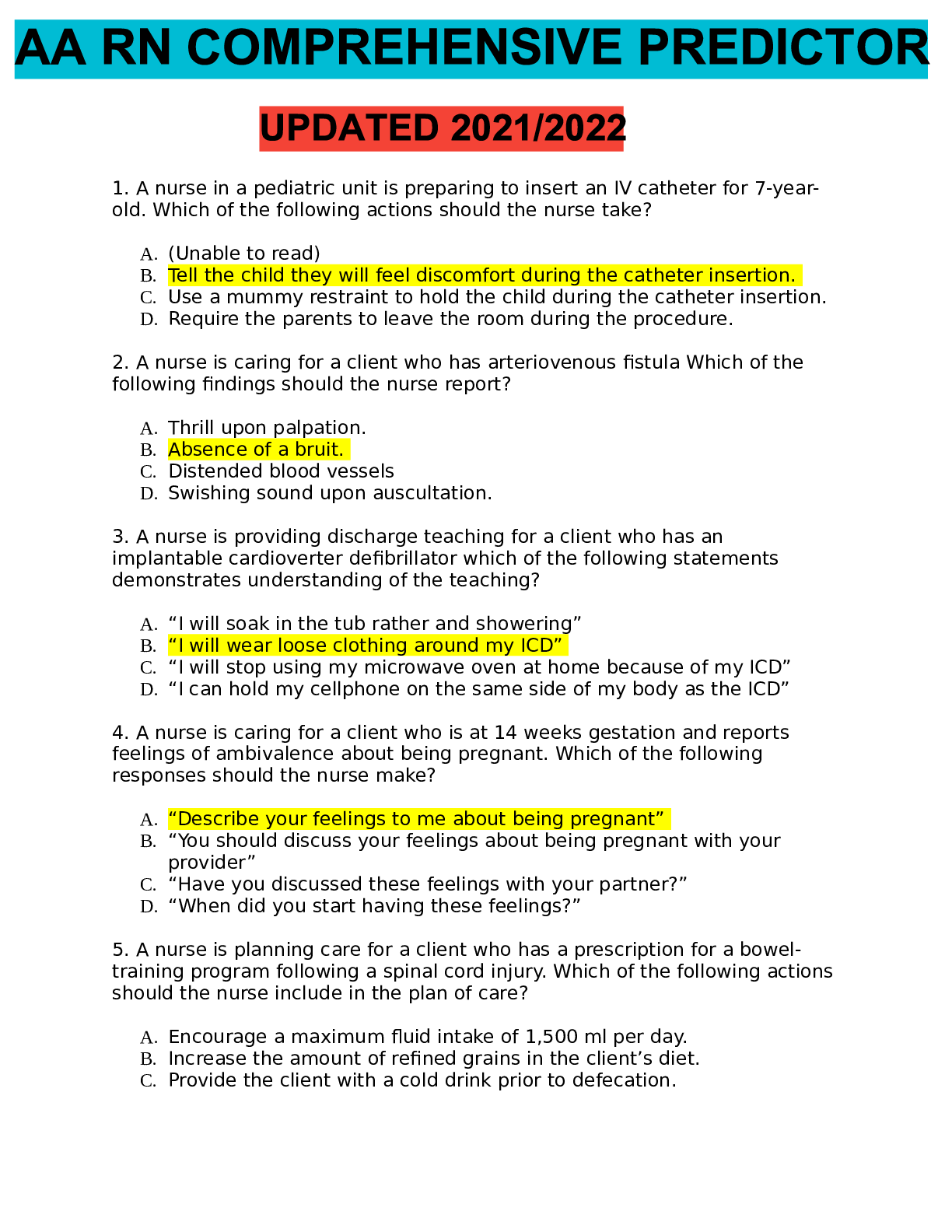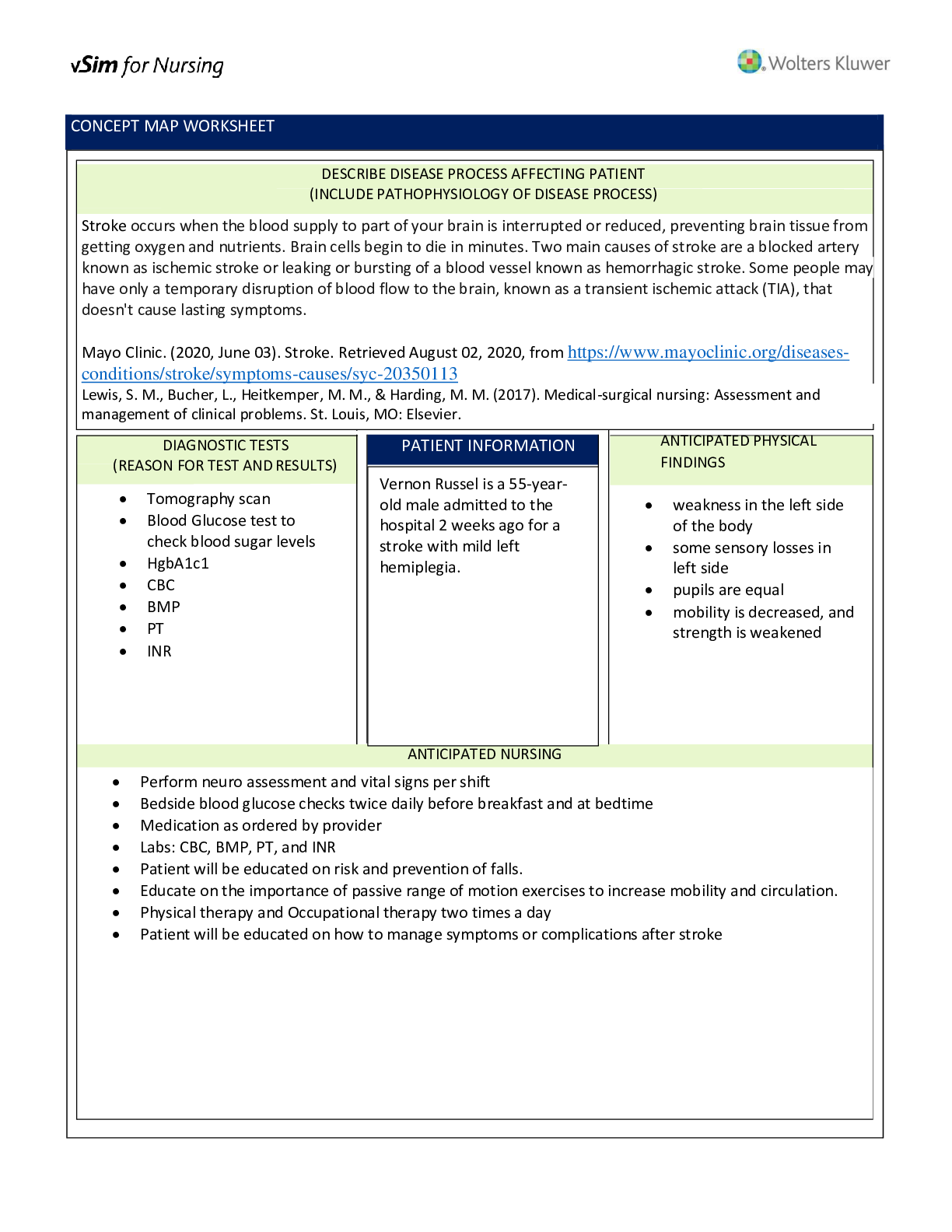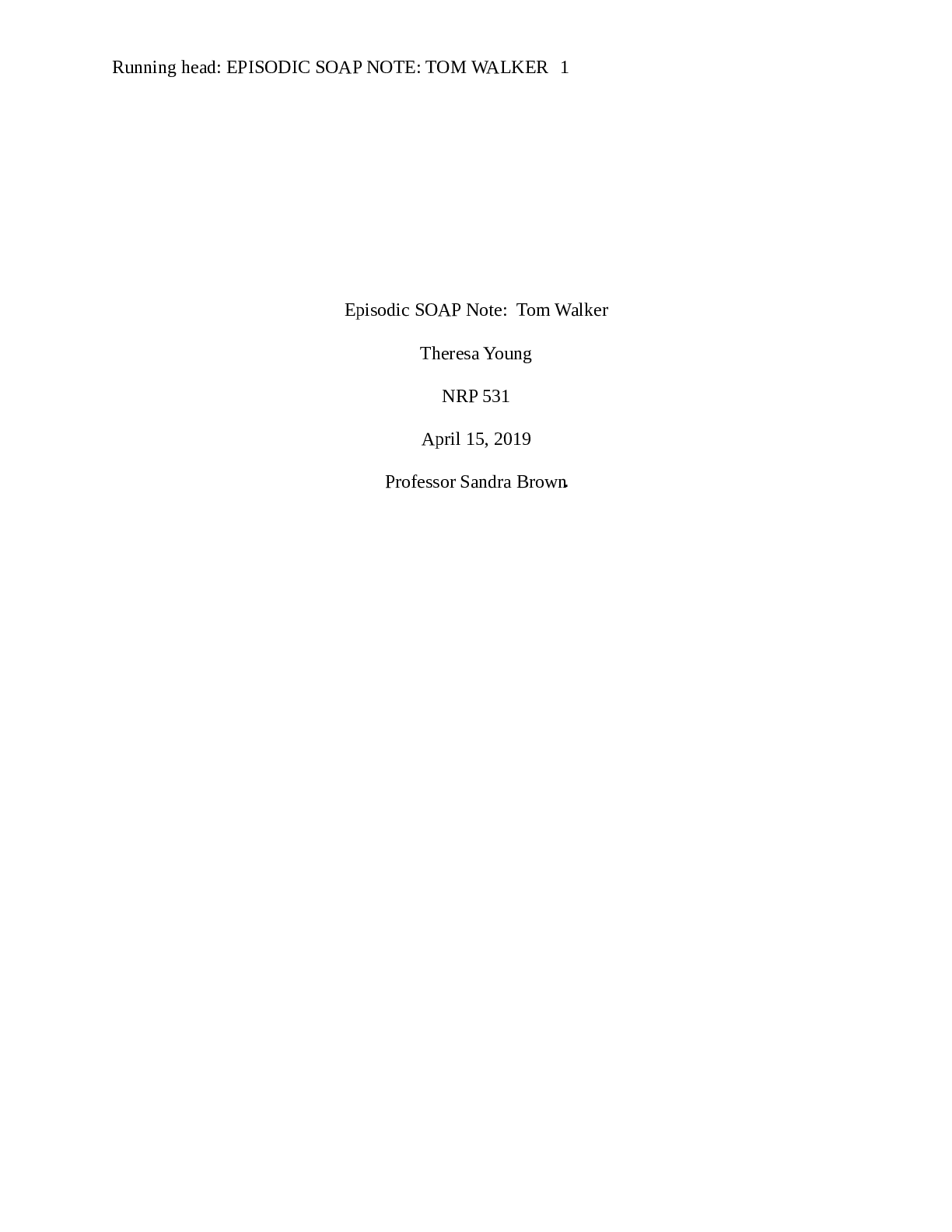*NURSING > CASE STUDY > NR-305 Week 7 Graded Discussion Topic: Debriefing the Week 6 Head to Toe Assessment Assignment (All)
NR-305 Week 7 Graded Discussion Topic: Debriefing the Week 6 Head to Toe Assessment Assignment
Document Content and Description Below
NR-305 Week 7 Graded Discussion Topic: Debriefing the Week 6 Head to Toe Assessment Assignment Discussion In Week 6 you demonstrated a head to toe assessment of an adult participant. This week you and... your classmates will reflect on the assessment you performed for your video assignment, and also apply this week's lesson on family assessment. Please consider the following in your initial post: 1. Reflect on the assessment you performed for the video assignment. Perhaps you might compare your performance now, to how it might have been different when you were a brand new nurse? Or share something you learned (or were reminded of) by participating in this activity? 2. Based on your observations, do you feel that patient assessments performed in practice are as thorough as they should be? Explain your answer. 3. This week's lesson focuses on assessment of families and introduces specific assessment opportunities for racially diverse, same sex, and adoptive families. Select one of these three non-traditional families. How would your assessment technique change to be sure that you were competently caring for a member of this type of family unit? This may include questions you would add to the health history, or ways in which you would communicate. I was nervous when I saw that we need to perform a head to toe assessment video for week 6 but then opted for the alternate assignment due to the current situation that we’re all experiencing. As a Registered nurse (RN) the past year and a half, I believe that I am still learning the proper way on doing a head to toe assessments. I was an LPN for 8 years however, all the places I had worked, RN’s do the assessments and it wasn’t a full head to toe assessment all the time. For example, the RN would need to assessment the residents after a fall to see if they would need to be sent to the hospital for more testing or if we’re able to get the resident up ourselves and just notify the doctor and family about the fall. During week 6, I learned a lot such as assessing lymph nodes that I had never seen performed during admissions. According to Epstein et al., (2017), “The head and neck region contain s several lymph nodes and glands, some of which have been associated with increased prevalence of cancer” (p. 20). I believe that assessments are not thorough enough due to time limitations. In my own experience I can say that it is very difficult to performed a thorough assessment because our patient ratio is 1:6 in which time is vital. Even with our advance technology today, EMR is a time-consuming process for nurses. Hendrich et al., (2008), mentioned “three subcategories accounted for most of nursing practice time: documentation (35.3%; 147.5 minutes), medication administration (17.2%; 72 minutes), and care coordination (20.6%; 86 minutes). Patient care activities accounted for 19.3% (81 minutes) of nursing practice time, and only 7.2% (31 minutes) of nursing practice time was considered to be used for patient assessment and reading of vital signs”. Even nurses are known to multitask, time is the most difficult to divide when patient ratio are high and EMR should be an advantage for nurses not a burden. Lesbian, Gay, Bi-sexual, Transgender, and Queer (LGBTQ) are a big part of our society. As a part of the LGBTQ, I chose to discuss this type of non-traditional family. I believe that more education should be given to the public and healthcare providers. According to Devine (2017), “To understand the needs of LGBTQ patients, nurses must expand their own knowledge on the subjects of sexual orientation (SO) or attraction, and gender identity (GI), or how one identifies with and experiences the world. Sexuality has long been defined as heterosexual by the dominant society, yet in reality, it encompasses a spectrum of needs, desires, and behaviors that can be fluid and changing over time”. When performing assessment to a transgender or lesbian patient, “Preferred name” should be included. Partners, significant other, husband/wife, and etc. should be also part of assessments. For example, education about HIV and STI’s are common in a walk -in clinic settings. Both individual should be present so we can provide quality care. As a member of LGBTQ family, providing a welcoming environment is important. It is also important not to make assumptions of their gender based on appearance. Before we can provide a safe quality care to LGBTQ families, it is essential for all healthcare providers to have education/in-service with non-traditional families. Did you know that “Through the Affordable Care Act, the Department of Health and Human Services (HHS) promotes cultural competency training for healthcare providers, allocates resources for improving the primary-care workforce, and increases funding for community health centers to address healthcare inequity among the LGBT population. In addition, HHS now requires equal visitation rights for same-sex partners. Starting in 2011, the Joint Commission (JC) began requiring hospitals to demonstrate how they are specifically responding to LGBT patients’ needs as part of the more comprehensive provider/patient communications standards for accreditation” (AmericanNurseToday, 2013). References American Nurse Today, (2013). Caring for older lesbian, gay, bisexual, and transgender adults. AmericanNurseToday. Retrieved from Devine, A. (2017). 10 tips for caring for LGBTQ patients. N. Retrieved from Epstein, I., Masita, S., Peisachovich, E., Da Silva, C., Grosman-Rimon, L., Lee, C., … Eliadis, M. (2017). The practice and teaching of palpation of the head and neck: A scoping review. Journal of Nursing Education and Practices. doi: 10.5430/jnep.v7n12p20. Retrieved from Hendrich, A., Chow, M., Skierczynski, B., & Lu, Z. (2008). A 36-hospital time and motion study: How do medical-surgical nurses spend their time?. The Permanente Journal 12(3), 25-34. Doi: 10.7812/tpp/08-021. Retrieved from [Show More]
Last updated: 2 years ago
Preview 1 out of 2 pages

Buy this document to get the full access instantly
Instant Download Access after purchase
Buy NowInstant download
We Accept:

Also available in bundle (1)

NR 305 Entire Course Weeks 1 – 8 Bundle
NR 305 Entire Course Weeks 1 – 8 Bundle NR 305 Entire Course Weeks 1 – 8 Bundle
By Grademaster 4 years ago
$33
11
Reviews( 0 )
$5.00
Can't find what you want? Try our AI powered Search
Document information
Connected school, study & course
About the document
Uploaded On
Dec 20, 2020
Number of pages
2
Written in
Additional information
This document has been written for:
Uploaded
Dec 20, 2020
Downloads
0
Views
102















